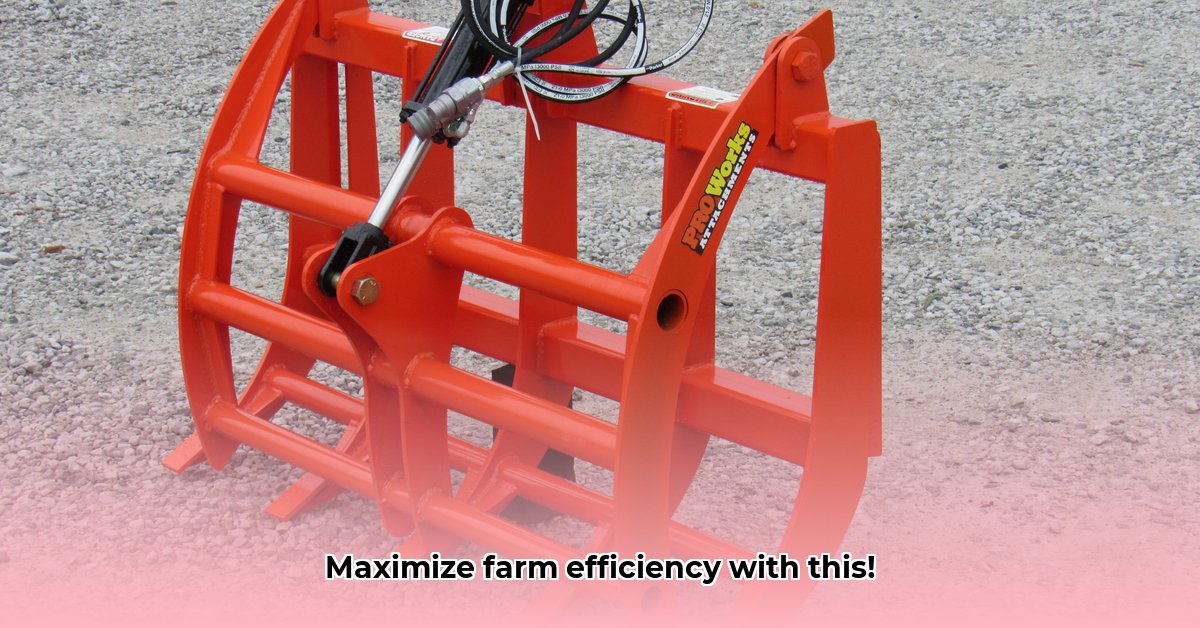
Choosing the right compact tractor grapple bucket can significantly boost your farm's efficiency and ease your workload. This guide helps you navigate the selection process, from understanding different types to ensuring safe and sustainable use. For more information on attachments, check out this helpful resource.
Understanding Grapple Bucket Types
Two main types of grapple buckets cater to different needs: root rakes and long-bottom grapples.
Root Rakes: These resemble powerful claws, ideal for digging up roots, moving debris, and precision gripping of smaller items. Their pointed tines allow for detailed work in tight spaces, though their capacity is lower than long-bottom grapples.
Long-Bottom Grapples: These function like sturdy scoops, excelling at moving larger volumes of material such as rocks, brush, or compost. Their higher capacity means fewer trips, but they lack the precision of root rakes.
Choosing between these depends entirely on your primary tasks. Will you be focusing on detailed work or moving large quantities of material? The answer guides your selection.
Key Factors When Choosing a Grapple Bucket
Several crucial factors influence your decision:
Material Durability: Opt for high-strength steel, such as Hardox AR450, for superior longevity and resistance to damage. This translates to a longer lifespan and reduced replacement costs. A durable grapple is a cost-effective investment in the long run.
Manufacturer Reputation: Thorough research is vital. Check online reviews, examine warranties, and seek out farmers' testimonials. A reputable manufacturer provides both quality products and reliable customer support. This impacts both your immediate satisfaction and your long-term experience.
Ease of Use: Simple attachment and intuitive controls save you time and effort. Smooth hydraulic operation is crucial for efficient and safe usage. A user-friendly grapple minimizes frustration and maximizes productivity.
The following table summarizes these key considerations:
| Feature | Optimal Choice |
|---|---|
| Material Durability | High-strength steel (e.g., Hardox AR450) |
| Manufacturer Reputation | Established brands with positive reviews and robust warranties |
| Ease of Use | Simple attachment, intuitive controls, smooth hydraulic operation |
A Comparative Analysis: The Need for Standardized Testing
Direct comparisons between brands are difficult due to the absence of industry-wide standardized testing. Manufacturers, such as MTL and Everything Attachments, may highlight specific features (e.g., opening capacity, root rake design), but without objective data on clamping force, cycle times, and material handling efficiency, definitive recommendations remain challenging. We strongly advocate for increased transparency and standardized testing from manufacturers to enable more informed purchasing decisions.
Installation and Maintenance: A Step-by-Step Guide
Attaching your grapple bucket involves several key steps:
Secure Connection: Carefully attach the grapple bucket to your compact tractor's three-point hitch, following both your tractor and grapple bucket manuals precisely. This ensures safety and efficient operation.
Hydraulic Hookup: Connect the hydraulic lines securely to the grapple bucket's ports, ensuring leak-free connections to prevent both fluid loss and potential hazards.
Test Run: Before any heavy work, test the opening and closing mechanisms to verify functionality and responsiveness. This step is critical for identifying potential problems before they become major issues.
Regular maintenance is crucial for extending the grapple bucket's lifespan. After each use, inspect for damage; lubricate moving parts according to the manufacturer's recommendations. Proactive maintenance prevents costly repairs and ensures continued safe operation.
Safety Considerations: Prioritizing Safe Operation
Safety is paramount. Always conduct a thorough pre-operation inspection for damage. Wear appropriate safety gear, including gloves and eye protection. Operate the grapple bucket smoothly, avoiding jerky movements. Never exceed the bucket's rated capacity.
A simplified risk assessment is shown below:
| Hazard | Likelihood | Severity | Mitigation |
|---|---|---|---|
| Material Failure | Low | High | Regular inspection, high-quality materials |
| Hydraulic Failure | Moderate | Medium | Regular fluid checks and maintenance |
| Improper Attachment | Low | Medium | Precise adherence to manufacturer's instructions |
Sustainability Considerations: Minimizing Environmental Impact
Choosing a durable grapple bucket reduces the need for replacements, minimizing waste and lowering your environmental impact. When the time comes for replacement, seek out recyclable or recycled-material options. Responsible land stewardship encompasses all aspects of your operation, including the equipment choices you make.
Conclusion
Investing in a compact tractor grapple bucket significantly enhances farm efficiency. Consider carefully the grapple type, durability, manufacturer reputation, ease of use, safety, and sustainability. Prioritize safety and maintain your equipment for optimal performance and longevity. Remember to consult manufacturer websites for further details and specifications.